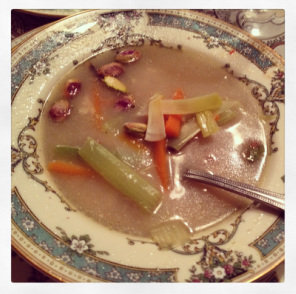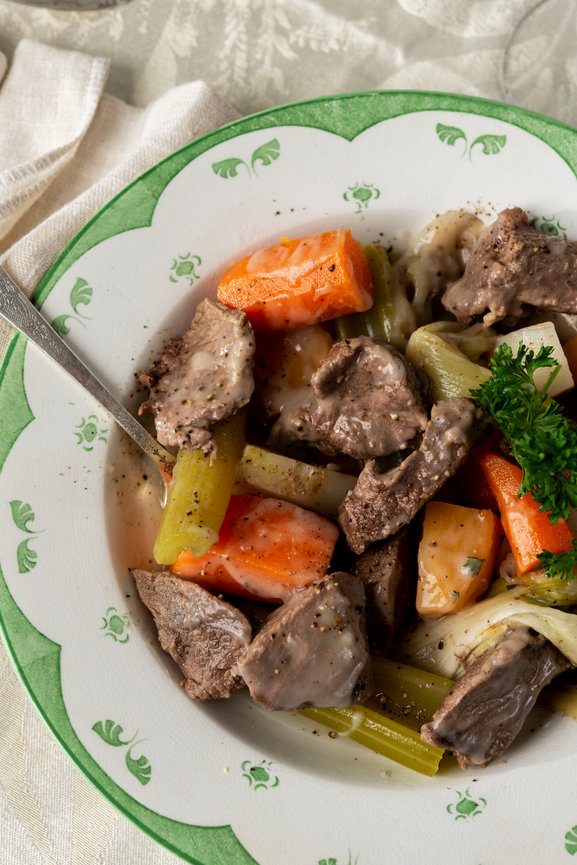Lobster Fricassee
Monday, July 28, 2014 | By: Becky Diamond
The other night I made lobster fricassee – a recipe straight out of Eliza Leslie’ 1844 cookbook Directions for Cookery and it was simply delicious. A fricassee is a kind of ragout usually made from white meat or poultry. The meat is browned lightly and then treated as in a white stew. The term migrated into English from the French, and originally meant any meat fried in a pan (including chicken, veal, lamb, or fish), and then smothered in a thickened white or brown stock.
Today’s version usually calls for sautéing the meat (particularly poultry or veal), coating it with flour and then cooking it in a white stock, typically cream-based and sometimes garnished with glazed pearl onions and/or lightly cooked mushrooms. When made with fish, the fish is usually first fried and then cooked in a white sauce.
Fish and shellfish have always been a popular and essential food source for communities located within the vicinity of the ocean and other sources of water. In the 19th century, the advent of the railroad and faster ships allowed folks in more distant locations to enjoy these delicacies of the sea, including lobster. The canning industry also began to take off at this time, allowing shellfish to be more widely available. In addition, Victorian Americans began placing a much higher social value on shellfish, especially oysters and lobster, which had been considered low-grade food by Europeans during the colonial era.
By the 1850s, lobster dishes were a popular dinner-party fixture on the tables of the uber-wealthy and influential. In Directions for Cookery, Miss Leslie gives instructions for how “to boil a lobster” and how “to dress lobster cold,” as well as recipes for stewed lobster, fricasseed lobster, potted lobster (“used to lay between thin slices of bread as sandwiches”), and lobster pie. Lobster salad was another common presentation, made using fresh or canned lobster.
But it was the fricasseed lobster that piqued my interest. I had purchased some lovely lobster tails at Whole Foods and was debating on how to prepare them. I thought about grilling or broiling, or maybe making a creamy sauce to serve over pasta, and just thought I would check to see how Miss Leslie suggested preparing them. I had heard of fricasseed chicken – after all this was one of Mrs. Goodfellow’s specialties – but never fricasseed lobster. I read the recipe and it was really so simple and sounded exactly like what I was looking for. In the 19th century, this dish would have been served more like a stew, but I thought serving over spaghetti would showcase the dish beautifully.
I was not at all disappointed, nor was my taste-tester husband. This dish was honestly restaurant quality. I followed Miss Leslie’s instructions almost exactly - the only difference is that I didn't boil the lobster for as long as her recipe suggests since I was using just lobster tails.
The result was a dish that was quick and simple, yet rich and elegant. Of course, it doesn’t take much for the delectable taste of lobster to shine – after all, the crustacean is considered one of the most luxurious of all seafood.
As a side I sautéed some fresh beet greens with a little red onion, garlic and golden raisins, finished with seasoned salt and a touch of lemon. This all paired perfectly with a nice bottle of Ticker Tape Chardonnay.
FRICASSEED LOBSTER
From Directions for Cookery by Eliza Leslie, 1844
Put the lobster into boiling salt and water, and let it boil according to its size from a quarter of an hour to half an hour.
The intention is to have it parboiled only, as it is afterwards to be fricasseed. Extract the meat from the shell, and cut it into small pieces. Season it With red pepper, salt, and nutmeg; and put it into a stew-pan with as much cream as will cover it. Keep the lid close; set the pan on hot coals, and stew it slowly for about as long a time as it was previously boiled. Just before you take it from the fire, stir in the beaten yolk of an egg. Send it to table in a small dish placed on a larger one, and arrange the small claws nicely round it on the large dish.
Sources: Dictionary of Gastronomy by Andre L. Simon and Robin Howe; Larousse Gastronomique by Joël Robuchon; The Oxford Companion to Food by Alan Davisdson; and Food in the United States, 1820s-1890 by Susan Williams







Leave a comment
0 Comments